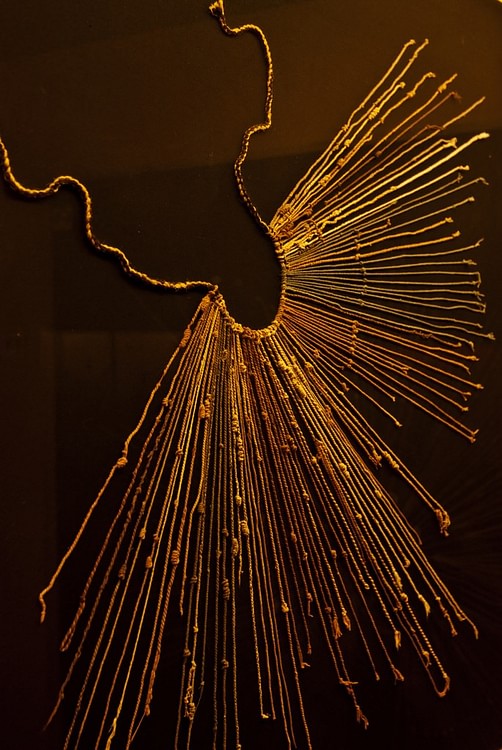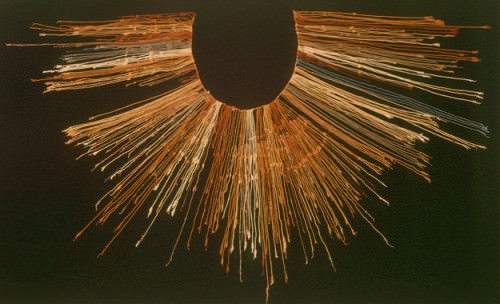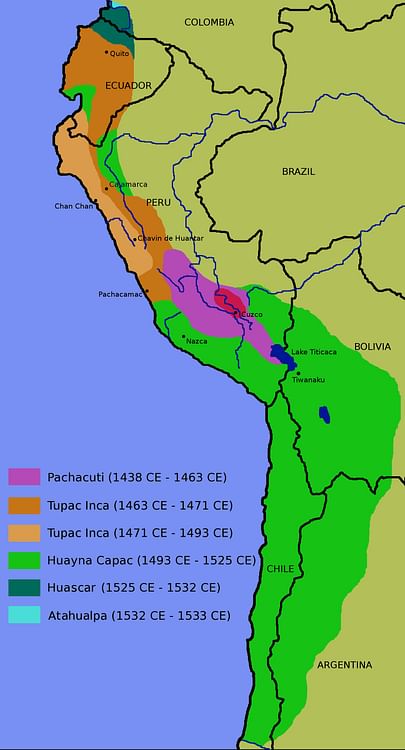Quipu › Wanka Civilization » Ancient origins
Articles and Definitions › Contents
- Quipu › Ancient History
- Wanka Civilization › Antique Origins
Ancient civilizations › Historical and archaeological sites
Quipu › Ancient History
Definition and Origins

A quipu , or knot-record (also called khipu ), was a method used by the Incas and other ancient Andean cultures to keep records and communicate information. In the absence of an alphabetic writing system, this simple and highly portable device achieved a surprising degree of precision and flexibility. Using a wide variety of colours, strings, and sometimes several hundred knots all tied in various ways at various heights, quipu could record dates, statistics, accounts, and even represent, in abstract form, key episodes from traditional folk stories and poetry. In recent years scholars have also challenged the traditional view that quipu were merely a memory aid device and go so far as to suggest that quipu may have been progressing towards narrative records and so becoming a viable alternative to written language just when the Inca Empirecollapsed.
METHOD
A typical quipu consists of a horizontal string or even wooden bar, from which hang any number of knotted and coloured strings made from either cotton or wool. Some of the larger quipu have as many as 1500 strings, and these could also be woven in different ways suggesting this, too, had a meaning. The various colour shades used could also carry a specific meaning. So, too, the type of knot, the position of it on the string, the total number of knots and the sequence of the knots could all combine to create a potentially huge number of meanings. The whole method was based on a decimal positional system, with the largest decimal used being 10,000. The Inca mathematical system was almost exactly the same as our own system in use today. The numbers or units in the system on a particular quipu are indicated by the strings furthest from the primary string, acting as a sort of key.
Different types of knots had different meanings. For example, a knot could indicate a number from one to nine by the turns of string within the knot, a figure-of-eight knot could indicate a fixed value, a 'granny' knot equalled ten, and a string missing a knot signified zero. Secondary strings could also hang from any single string and these could indicate that this string was an exception or of secondary importance to the other strings. Finally, individual quipu could join with others in a specific and meaningful sequence.
KNOTS AND COLOURS COULD COMBINE TO CREATE A POTENTIALLY HUGE NUMBER OF MEANINGS.
Naturally, to maximise the quipu 's potential for information storage, it was better to have an accompanying oral record and so there grew a body of experts or masters, the khipu kamayuq (also quipucamayos ). These individuals memorized the oral account which fully explained a particular quipu and, as the job was hereditary, the oral part was passed from generation to generation. There was a certain pressure attached to the job, however, as lapses in memory could be severely punished.
PURPOSE
At Cuzco, the Inca capital, the khipu kamayuq were professionals, and besides keeping official records, they also used quipu as an aide memoire to recount stories, myths and poems from the Inca tradition. Quipu were also used to record imperial conquests and royal blood-lines. They were ideal for recording the census data for provinces, ie total numbers, specific numbers of males and females, children, married and unmarried, etc. Other kinds of data that quipu were used to record included accounts, stores, taxes (paid in kind), livestock, land measurements, armies and their equipment, astronomy, and calendars. Quipu were also used, along with a short oral description, by Inca postal messengers ( chaski ).

Quipu
SURVIVING EXAMPLES
Many Inca quipu were purposely destroyed when Atawalpa took power and sought to clean the slate of Inca history, and, in particular, destroy the historical record concerning the reign of his bitter rival and half-brother, Waskhar. Then, following the Spanish conquest, even more quipu records were sought out and destroyed, the new rulers being highly suspicious of the information they might contain within their knots. As a result of these actions, only several hundred examples of quipu survive today. However, quipu are still used by Andean people even today, most often by shepherds and herders as a method to record livestock numbers.
Wanka Civilization › Antique Origins
Definition and Origins

The Wanka (also Wanca or Huanca ) people occupied the highlands of ancient central Peru around Lake Junin and the Manataro, Chanchamayo and Tarma rivers. The culture flourished from the Middle to Late Horizon periods (600 CE - 1532 CE). Dwelling in fortified hill-top settlements, they largely specialised in llama herding. As with other cultures in the area, herding was long-preferred over farming. It was not until c. 1000 CE that intense maize farming began, much later than in other contemporary cultures. This shift in agricultural practice was motivated by changes in settlements and a significant increase in population density. Now concentrated in walled towns, the capital city of the Wanka was established at WariWillka.
Wanka art and architecture across their different settlements were influenced by the nearby Huari culture and the Ayacucho style. Settlements vary in size with the majority having fewer than 50 buildings but several having over 100. Most buildings were circular and arranged in small groups of up to twelve around an open courtyard. There is not much evidence of town planning, although some settlements were constructed in pairs in close proximity.
THE WANKA PROVIDED STIFF RESISTANCE TO THE INCA EMPIRE UNTIL THEIR FINAL DEFEAT AT THE HANDS OF THE GREAT INCA LEADER PACHACUTI.
The Wanka provided stiff resistance to the Inca Empire until their final defeat at the hands of the great Inca leader Pachacuti (r. 1438 - 1471 CE). The Incas shifted populations to lower-level locations and administered the area from an imperial centre at Jaujatambo. Agriculture became better organised in order to produce quotas for the Inca state and large storage buildings ( qollqa ) were built.
Never wholly subjugated to Inca rule, the Wanka were often embroiled in border disputes with their neighbours the Xauxa, and the Incas describe the Wanka as being continuously plagued by internal disputes. Nevertheless, they became keen allies of Pizarro in his conquest of the Inca Empire. The Wankas also helped the Spanish Crown put down several rebellions in the early decades of colonial rule in Peru, notably the defeat of Francisco Hernández Girón between 1553 and 1554 CE. Their name lives on today with the Peruvian city and province of Huancayo being named after them, as is the local football team Deportivo Wanka.
LICENSE:
Article based on information obtained from these sources:with permission from the Website Ancient History Encyclopedia
Content is available under License Creative Commons: Attribution-NonCommercial-ShareAlike 3.0 Unported. CC-BY-NC-SA License